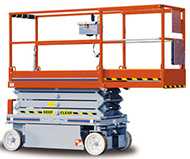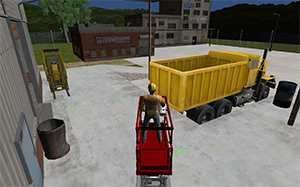FALLS IN THE WORKPLACE
Aerial Lifts

Aerial lifts are powered and mobile platforms that are used for elevating workers to various heights, which exposes workers to fall hazards.
Training is necessary for anyone using aerial work platforms and equipment. In an effort to create awareness about common workplace hazards when using aerial lifts, NIOSH has developed educational tools and products. Employers, trainers, safety and health professionals, and aerial lift operators can use the following information to prevent work-related falls.
Note: NIOSH uses the term ‘aerial lifts’ as an overarching term to capture multiple types of lifts, such as scissor lifts and boom lifts. It is important to note that both OSHA and ANSI standards vary for different types of lifts.
Spotlight
NIOSH Aerial Lift Hazard Recognition Simulator
 The Simulator, available at no cost, provides a realistic workplace with multiple, dangerous hazard types that users must navigate. Experienced aerial lift operators can refresh their knowledge, and new operators can familiarize themselves with hazards they may encounter on the job. Using the Simulator is not a substitute for required training to operate an aerial lift.
The Simulator, available at no cost, provides a realistic workplace with multiple, dangerous hazard types that users must navigate. Experienced aerial lift operators can refresh their knowledge, and new operators can familiarize themselves with hazards they may encounter on the job. Using the Simulator is not a substitute for required training to operate an aerial lift.
Use the NIOSH Aerial Lift Hazard Recognition Simulator today! See ‘Tools’ below for instructions to launch the Simulator from your computer.
Fast Facts
Falls are the leading cause of death for construction workers, killing more than 200 U.S. workers each year.1
Between 2011-2014, 1,380 workers were injured as a result of operating an aerial lift or scissor lift. 360 of these injuries were a result of slips, trips, and falls from one level to another.2
Between 2011-2014, 87 workers died as a result of operating an aerial lift or scissor lift. 48 of these deaths were a result of slips, trips, and falls from one level to another.3
1CPWR: The Center for Construction Research and Training. Stop Construction Falls: About the Campaign (Accessed September 1, 2016).
2US Department of Labor, Bureau of Labor Statistics Survey of Occupational Injuries and Illnesses (nonfatal data). Date accessed: July 18, 2016.
3US Department of Labor, Bureau of Labor Statistics Census of Fatal Occupational Injuries query system (fatal data). Date accessed: July 18, 2016.
Questions & Answers
Why are aerial lifts used?
Aerial lifts are used to elevate workers to various heights to perform a variety of work-related tasks, including: painting, drywall installation, and maintenance. Aerial lifts are mobile making them easy to deploy to a number of jobsites, plus they involve minimal setup time. For these reasons, aerial lifts are often used instead of scaffolding.
Where are aerial lifts used?
Aerial lifts are popular at various jobsites including:
- Construction
- Telecommunication
- Warehousing
- General building maintenance
- Other industries that are required to elevate workers to: move materials, change lightbulbs, store boxes, and other tasks
What are the risks associated with using aerial lifts?
Aerial lifts can expose workers to risks, such as falls, because they are mobile, used as elevating equipment, and are considered a restricted work space. Aerial lifts are used in a number of different conditions, such as adverse weather conditions and high-traffic, continually-changing worksites. These conditions create other hazards that expose workers to injury, including crushing/trapping hazards, electrocutions, and tip overs. Proper safeguarding can reduce or eliminate injury events.
Standards
Recommended safe work practices for aerial lifts are included in ANSI Standards and OSHA Requirements.
Tools & Products
NIOSH Aerial Lift Hazard Recognition Simulator
The Simulator is designed to help potential aerial lift operators acclimate to aerial lift operation and to identify the common occupational hazards during use, such as depressions (potholes), crushing hazards, tip over hazards, etc. Using the Simulator is not a substitute for required training to operate an aerial lift.
To launch the Simulator:
- Click on the Launch Aerial Lift Hazard Recognition Simulator button below to download the Simulator.
- Click Open on the menu
- Double click AerialLiftSimulation Application
- Click Extract All
- Click Browse to select or create a folder location on your computer’s hard drive. Do not select a networked shared drive.
- Select “Extract” (one folder and one application file will download).
- Double click AerialLiftSimulation Application to run the Simulator.
- Select the screen resolution and graphics quality. (The default setting for the screen resolution and graphics (“good”) should work on most computers).
- Enable the audio on your computer. Directions are provided audibly.
- Click Play!
To use the Simulator:
- Once launched, you the will be prompted to position the lift in the appropriate area while avoiding hazards.
- To maneuver the lift use your keyboard. Press “h” if you require assistance.
- Follow the green arrows and align the lift with the transparent platforms visible at various locations in the work area.
- You will be notified when you have reached each target area successfully.
- To finish the scenario, park the lift at the final location.
Products
 Aerial lifts, commonly used on construction sites, expose workers to falls. To prevent these falls and other aerial lift-related injuries and deaths, NIOSH developed the Aerial Lift Hazard Recognition Simulator. This flyer gives employers, trainers, safety professionals, and aerial lift operators information on the Simulator and how to access it.
Aerial lifts, commonly used on construction sites, expose workers to falls. To prevent these falls and other aerial lift-related injuries and deaths, NIOSH developed the Aerial Lift Hazard Recognition Simulator. This flyer gives employers, trainers, safety professionals, and aerial lift operators information on the Simulator and how to access it.
Other Resources
The following pages contain helpful information related to the safe use of aerial lifts:
NIOSH computer simulation tests
List of NIOSH and stakeholders publications
To address aerial lift safety, NIOSH studied and tested elevating devices, specifically the ability of aerial lifts to resist and survive commonly encountered occupational exposures (e.g., pothole depressions, curbs, and horizontal load tests). Exposures examined were primarily those defined by the ANSI standard (A92), which is a mandatory standard by OSHA (A1926.453).
Acknowledgements
NIOSH wishes to acknowledge the comments and input from the following ANSI committees, representatives and individuals, in reviewing the NIOSH topic page to help ensure that standards and industry-wide procedures for safe operation of aerial lifts were included: ANSI A10.29, A92, as well as Dennis W. Eckstine (Eckstine & Associates, Inc.), Chuck Wigger (Lamar Advertising Company), F.G. (Rick) Heath (Heath and Associates), Michael J. Kassman (International Masonry Training and Education Foundation), Tony Groat (International Powered Access Federation), Denise Almonte (Safety First), and Dave Merrifield (Scaffold Access and Industry Association).
- Page last reviewed: April 12, 2017
- Page last updated: December 1, 2016
- Content source:
- National Institute for Occupational Safety and Health Division of Safety Research


 ShareCompartir
ShareCompartir